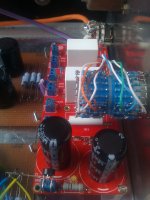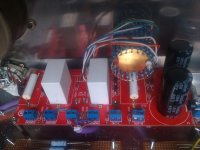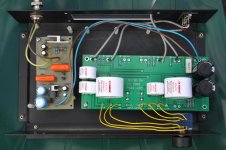I can't believe. Another russian cap I've tried in 1uf place produces hum when turning the pot up....
I have a problem here having sound output from the B1 quieter than i put in at about 10% of the original signal, the only thing i could have done wrong i guess is wire up transistors wrong way or the attenuator/volume control.
Power is on and all good, any ideas ? time for some detective work i guess!
Power is on and all good, any ideas ? time for some detective work i guess!
Last edited:
B1 with lower ps voltage: 12-14V?
I did a quick search but didn't find anything specific ... 🙁
Loving my B1! 😀
Thinking of another circuit, can the B1 work with lower ps voltage: 12-14V?
From the 2SK170 datasheet:
Note: IDSS classification GR: 2.6~6.5 mA, BL: 6.0~12 mA, V: 10~20 mA
Would it be as simple as using the GR grade (2.6~6.5 mA) instead of the BL grade (6.0~12 mA)?
Or are different FETs required?
Cheers,
Jeff
I did a quick search but didn't find anything specific ... 🙁
Loving my B1! 😀
Thinking of another circuit, can the B1 work with lower ps voltage: 12-14V?
From the 2SK170 datasheet:
Note: IDSS classification GR: 2.6~6.5 mA, BL: 6.0~12 mA, V: 10~20 mA
Would it be as simple as using the GR grade (2.6~6.5 mA) instead of the BL grade (6.0~12 mA)?
Or are different FETs required?
Cheers,
Jeff
Last edited:
Disconnected input wires - no change
Volume up full and B1 output is quieter than output from audio source (this part surely not a grounding issue ?)
taking ground lead from F5 to B1 outputs makes more hum
Tried laptop PSU same problem!
Volume up full and B1 output is quieter than output from audio source (this part surely not a grounding issue ?)
taking ground lead from F5 to B1 outputs makes more hum
Tried laptop PSU same problem!
Last edited:
I have a lovely 50Hz hum on This B1 sounds the same as the transformer 🙁
CHECK your grounding !!!!
Disconnected the whole B1 lol and problem there, as soon as i plug in the music source hum, if i unplug the source. in this case a mp3 player. hum goes.
Keep the same BL grade.I did a quick search but didn't find anything specific ... 🙁
Loving my B1! 😀
Thinking of another circuit, can the B1 work with lower ps voltage: 12-14V?
From the 2SK170 datasheet:
Note: IDSS classification GR: 2.6~6.5 mA, BL: 6.0~12 mA, V: 10~20 mA
Would it be as simple as using the GR grade (2.6~6.5 mA) instead of the BL grade (6.0~12 mA)?
Or are different FETs required?
Cheers,
Jeff
The dissipation will be a bit less due to less voltage.
That would allow a higher Idss if you have any.
But the Idss should be measured at the voltage the devices will see in the circuit.
If the B1 runs on 13Vdc then the Idss should be measured at 6.5Vds
A B1 does not need a dual polarity PSU.
You mention centre tap and I see two smoothing caps.
What supply have you ended up with?
You mention centre tap and I see two smoothing caps.
What supply have you ended up with?
Hi, thanks Problem seems to be a ground loop with the F5, the B1 is disconnected completely and there is hum still the same loud and same hum.
I have centre tapped transformer
2x 24v for the F5
2x 12v for the B1 (only one of the 12v)
I have centre tapped transformer
2x 24v for the F5
2x 12v for the B1 (only one of the 12v)
A B1 does not need a dual polarity PSU.
You mention centre tap and I see two smoothing caps.
What supply have you ended up with?
From experience I an tell that the DCB1 (with symmetrical supply and no input/output caps) beats an asymmetrical fed B1. Win-win situation: cheaper and better. No need for using brick sized caps then.
Are you sure 12v can sound ok ? im running the B1 on 13v at the moment as I only have 13 or 26 avalible, the 13v sounds distorted at high levels to me.
Does anyone know if i can run the B1 at the 26volts i have ? would I need to change anything thanks ?
got rid of all my hum problems btw learnt a lot!
Does anyone know if i can run the B1 at the 26volts i have ? would I need to change anything thanks ?
got rid of all my hum problems btw learnt a lot!
You can run it on 26V provided your power caps are rated more than 25 V. Otherwise need to put 2 x 1n4001 in series of +V to lower voltage.
Diodes are a good idea but please overrate your caps by around 25% to avoid damage.
If I recall consensus around here was 13.8V was best subjectively. Is the distortion actually voltage related?
If I recall consensus around here was 13.8V was best subjectively. Is the distortion actually voltage related?
Thanks, the actual voltage that was read when connected to the B1 was 32v I listened for a few seconds of music and found there was no limiting/distortion effect like there was with 13v (ac-centre tap)
Strangely after the rectifier i measure 22v but when plugged into the B1 i read 33v (ac-ac)
the answer to this I don't get lol
May use a regulator Andrew thanks, Diode trick is a new one on me! 🙂
Would upgrade my caps to 50v so they can handle the 33v power supply but am wondering if the B1 can handle 33v ok.
Strangely after the rectifier i measure 22v but when plugged into the B1 i read 33v (ac-ac)
the answer to this I don't get lol
May use a regulator Andrew thanks, Diode trick is a new one on me! 🙂
Would upgrade my caps to 50v so they can handle the 33v power supply but am wondering if the B1 can handle 33v ok.
Last edited:
B1 transformed
Hi all,
I’ve recently built a B1 using a Pass DIY PCB and have been listening and experimenting with different capacitors. I have tried some audio grade MKP types from Maplin on their own and with low value (100nF) bypass caps and also some Mundorf aluminium – oil types from Hifi Collective wih and without the bypass capacitors. All combinations sound different with the ally – oil types on their own sounding nicest.
The B1 is powered using a simple linear regulator circuit with a John Linsley Hood shunt regulator across it giving about 18.6 volts. I am quite a fan of these shunt regulators and have been using a pair on the supply to a Linsley Hood discrete component shunt feedback phono stage for nearly 20 years and they made an impressive improvement to the sound (using a low output moving coil cartridge) when I added them.
After initial listening I had to agree with KatieandDad’s opinion (in the B1 Builders thread) that the sound lacks excitement. It’s as if the “attack” and dynamic impact of the music is diminished. Also the stereo soundstage has somehow shrunk. I had a long listen and eventually re-connected my 26 year old (it’s older than I was when I bought it!) Audiolab 8000C preamp.
Since starting a two week summer break I’ve had loads more time to experiment and have since moved my speakers approximately 6 inches further into the room and put crosshead screws into the floorboards to locate the spikes into – they now feel far more stable and rigidly mounted. After lots and lots of hours further listening something remarkable has happened; the sound has become simply stunning and transparent. The attack and dynamic impact are better than ever and stereo soundstage is huge and most definitely 3D. Super smooth and highly detailed but without the bright slightly cold and clinical nature of the Audiolab. I’m using A40 class A monoblocks with KEF Q7 speakers.
I am starting to think that the mundorfs may have taken many, many hours of use before they started to sound any good. Has anyone else used these capacitors in a B1 and noticed this effect? Also, KatieandDad, did you manage to get your B1 sounding good?
Now, I think I’d better get around to making a decent case for my B1 now its performing good!
Regards,
Earthloop
Hi all,
I’ve recently built a B1 using a Pass DIY PCB and have been listening and experimenting with different capacitors. I have tried some audio grade MKP types from Maplin on their own and with low value (100nF) bypass caps and also some Mundorf aluminium – oil types from Hifi Collective wih and without the bypass capacitors. All combinations sound different with the ally – oil types on their own sounding nicest.
The B1 is powered using a simple linear regulator circuit with a John Linsley Hood shunt regulator across it giving about 18.6 volts. I am quite a fan of these shunt regulators and have been using a pair on the supply to a Linsley Hood discrete component shunt feedback phono stage for nearly 20 years and they made an impressive improvement to the sound (using a low output moving coil cartridge) when I added them.
After initial listening I had to agree with KatieandDad’s opinion (in the B1 Builders thread) that the sound lacks excitement. It’s as if the “attack” and dynamic impact of the music is diminished. Also the stereo soundstage has somehow shrunk. I had a long listen and eventually re-connected my 26 year old (it’s older than I was when I bought it!) Audiolab 8000C preamp.
Since starting a two week summer break I’ve had loads more time to experiment and have since moved my speakers approximately 6 inches further into the room and put crosshead screws into the floorboards to locate the spikes into – they now feel far more stable and rigidly mounted. After lots and lots of hours further listening something remarkable has happened; the sound has become simply stunning and transparent. The attack and dynamic impact are better than ever and stereo soundstage is huge and most definitely 3D. Super smooth and highly detailed but without the bright slightly cold and clinical nature of the Audiolab. I’m using A40 class A monoblocks with KEF Q7 speakers.
I am starting to think that the mundorfs may have taken many, many hours of use before they started to sound any good. Has anyone else used these capacitors in a B1 and noticed this effect? Also, KatieandDad, did you manage to get your B1 sounding good?
Now, I think I’d better get around to making a decent case for my B1 now its performing good!
Regards,
Earthloop
Attachments
- Home
- Amplifiers
- Pass Labs
- B1 Buffer Preamp


